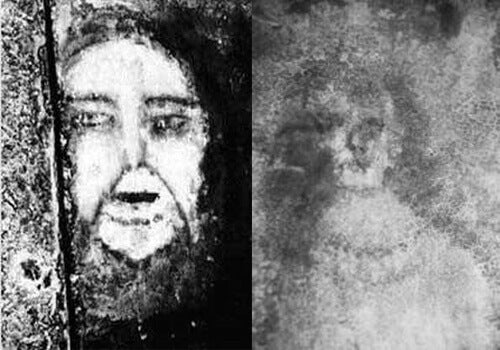Pareidolia happens when you see a face in a lock or a horse in a cloud, which is a normal experience. This term describes a psychological phenomenon where a person perceives a recognizable shape (usually an image) within a vague and random stimulus. The individual provides organization and meaning to an ambiguous or poorly structured stimulus.
Examples of pareidolia are those faces you see in the profile of a mountain or on the flames emerging from a chimney. This isn’t pathological at all, the inability to form them is. Thus, they constitute a magnificent example of an anomalous mental experience. The term anomaly, in this case, doesn’t imply a mental condition, disease, or morbidity.
“Walking up a road at night, I’ve seen a lamp and a lighted window and a cloud make together a most complete and unmistakable face. If anyone in heaven has that face I shall know him again.”
-Gilbert Keith Chesterton-
Pareidolia is a perceptual distortion
The classification of perceptual and imaginative disorders usually comprises two groups: perceptual distortions and perceptual delusions. These latter ones are only possible through the action of the senses.
These perceptual distortions occur when you perceive a stimulus that exists outside of you (accessible to the senses) in a way that differs from what you’d expect. The anomaly here is to perceive the physical characteristics of the stimulating world in a distorted way.
There are two ways of distortion for this purpose:
- A perception that’s different from the usual and more likely given previous experiences or the way in which other people perceive it.
- Also, a perception different from what would be, considering the physical configuration of the stimulus. Illusions belong to this category and it’s just what pareidolia is.
A new perception happens in the case of perceptual deceptions. This new one usually coexists with the rest of the “normal” ones. These deceptions have no basis on stimuli existing outside the individual (as in hallucinations).

How many types of perceptual distortions exist?
Here’s a classification:
- Hyperesthesias and hypoesthesias are anomalies in the perception of intensity (hyperalgesia and hypoalgesia, feeling more or less pain).
- Also, anomalies in the perception of quality refer to colored visions and changes in the perception of the color of objects.
- Metamorphopsias involve anomalies in the perception of size and/or shape.
- Anomalies in perceptual integration are rare anomalies that sometimes appear in organic states and in schizophrenia.
- Finally, there are two types of illusions: the feeling of a presence and pareidolias (the subject of this article).
As we can see, there are several perceptual distortions that we can experience, some more surprising than others. In the subject that concerns us, we see how pareidolia is a type of illusion.
Illusions are anomalies in the structuring of ambiguous stimuli
One can conceptualize an illusion as a perceptual distortion insofar defined as a “misperception of a particular object.” Thus, illusions are perceptions that don’t correspond to the objective physical characteristics of a particular stimulus.
From a classical psychological perspective, illusions are a byproduct of a tendency people have to organize, in a meaningful whole, elements more or less isolated from each other or from a background. There are many examples of illusions, such as the Müller-Lyer illusion or reversible figures. You can easily find them on the Internet.

Pareidolias influence human culture and religiosity
Many phenomena can be odd and even a source of jokes when observed superficially. This is the case of pareidolia. Do a search on the Internet and you’ll find references to a photograph of an explosion, or of the surface of another planet, a cloud, or simply a stain on the wall, in which people claim to see religious images, extraterrestrials, faces of people, animals, and even texts from sacred books.
The phenomenon of pareidolia also finds an outlet in auditory images. In the quetzal sound or in the echo of the pyramid of Kukulkan in Chichen Itza, for example. They’re also in the “voices” from beyond the grave, in the white noise of a TV set or in the records played backward, in which one can supposedly hear “satanic” messages.
Aniconic religions (which reject icons) such as Muslims and Jews, have their own manifestations associated with pareidolia. For instance, seeing the name of a god in clouds, snowy mountain spots, or aurora borealis among others, are often referred to as “Muslim pareidolia” and “Quranic miracles” among others.
The so-called secret codes of the Torah are well known among those in the Jewish religion. Mathematicians, experts in statistics, believe to find prophetic texts of present or future events in them. Some believe these are probably influenced by the phenomena of pareidolia.
The faces of Belmez are a known case of pareidolia
These faces are a phenomenon considered by the followers of parapsychology as paranormal. It consisted in the appearance of pigmentations, identified as faces, on the floor of a house located in Bélmez de la Moraleda. (Bélmez is a small town in the province of Jaén, Spain)-
This phenomenon began to occur in 1971. Adepts of parapsychology considered it “the most important paranormal phenomenon of the 20th century”. However, several scholars of the subject declared it a fraud.

It’s probably due to the phenomenon of pareidolia, since the faces that appeared in that house, in the form of humidity, could be due to perceptual distortion. Even so, the faces in Bélmez seemed so real some believe the owner of the house secretly made them.
Finally, pareidolia is a phenomenon that never ceases to amaze. Its explanation is basically the way humans organize stimuli in our minds. It’s simply an illusion, a perceptual distortion.
The post Pareidolia Is a Form of Incorrect Perception appeared first on Exploring your mind.



















Comments